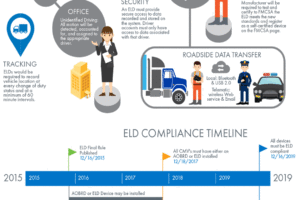While the mandate was intended to create safer working conditions for drivers, this industry change has had some road bumps. Lawmakers, enforcement officials, carriers and drivers are still adjusting to the impact of the ELD mandate on the day-to-day job of making sure goods get to their destinations. Fleet managers can help drivers using new ELDs or AOBRDS avoid getting citations when pulled over in three simple ways:
1. Implement regular refresher courses on using new devices or solutions: No matter how tech-savvy someone is, dealing with new technology always has a learning curve. The last place a driver wants to realize they’re on the low end of that curve is when they’ve gotten pulled over for an inspection. At regular intervals, fleet managers should ensure each driver truly knows how to use their device. Most vendors can provide or help managers create simple how-to-guides or user manuals, with many providing around the clock customer care every day of the year. Managers should also consider running simulations so drivers gain real-world experience responding to questions and requests from inspectors.
2. Ensure drivers truly understand what is required of them: Vehicles with AOBRDs or ELDs have slightly different legal requirements and drivers should be able to answer the simple question of which device they have. Drivers using an AOBRD should be able to state what data is recorded and what is displayed on the device, as well as provide a device instruction sheet and a supply of blank record-of-duty status graphs. Drivers using AOBRDs are not required to transfer data during an inspection but those using ELDs will need to be prepared to make a transfer on demand. With all these nuances, fleet managers should consider creating a cheat sheet of requirements for drivers depending on what device they have in their vehicle. After all, inspectors make mistakes too and if a driver truly understands their responsibilities, they can easily get ahead of incorrect citations.
3. Be aware of the most common violations: Knowing what the main pitfalls are for drivers during inspections will help fleet managers prepare and even help avoid citations by correcting behaviors and processes that could lead to risks. For example, while form and manner violations only add a point to a carrier’s CSA score, most HOS violations are attributed to incorrect logs. During the annual roadcheck in North America, inspectors will be conducting a Standard Level I Inspection. This is a 37-step process that includes driver and vehicle checks, so there’s plenty of chances for violations if a fleet manager or driver isn’t aware of what could go wrong.







